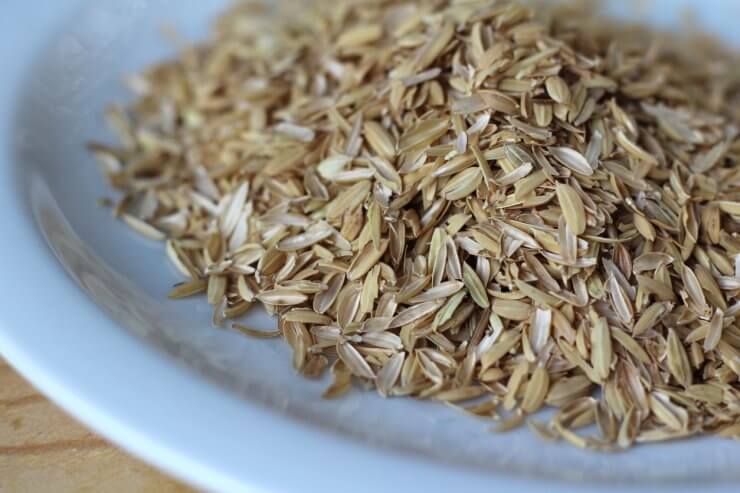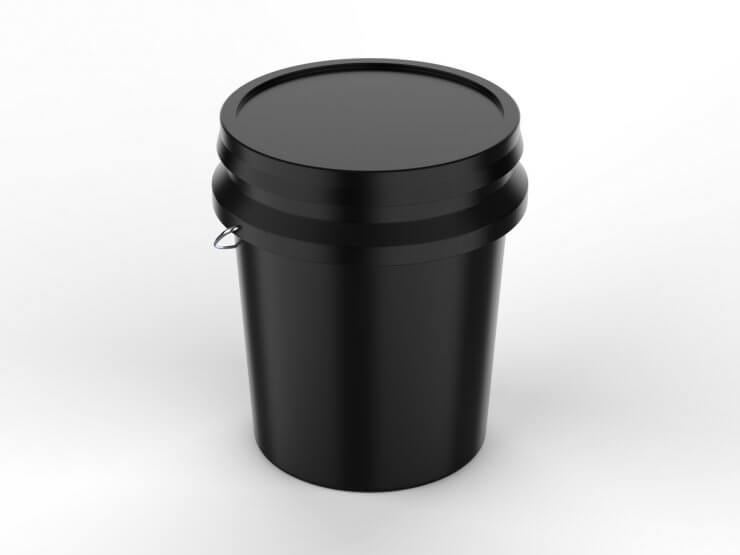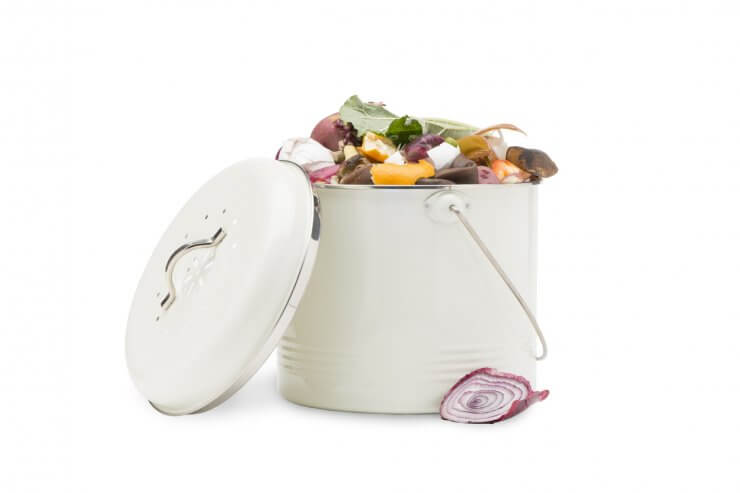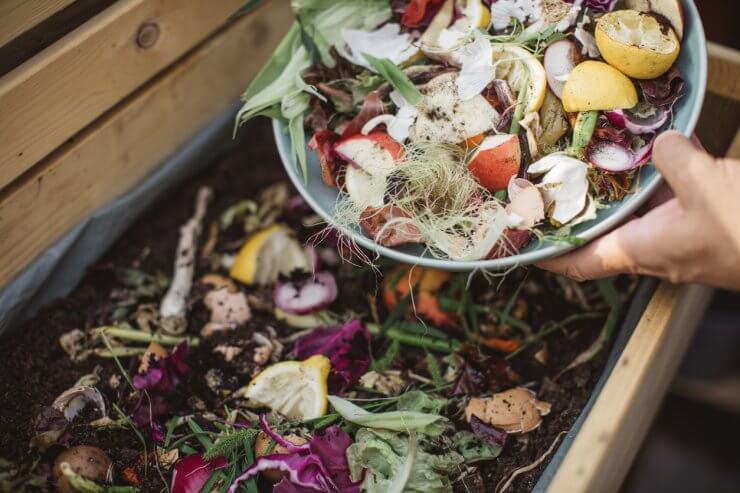
Whenever I get to write about composting, I get that feeling you have when you’ve discovered a great new TV show and want to share all about it with your friends. Basically, compost is my Bridgerton. I feel like I’m constantly learning techniques and methods for composting and each one is more interesting than the next. My latest obsession? Bokashi composting. Before I get into how to make bokashi compost, I wanted to share a little bit about what it is and why it’s beneficial for your herb and vegetable garden.
What is bokashi composting?
The word bokashi is a Japanese word that loosely translates to mean “fading away.” And that “fading away” action is exactly what happens with your food scraps using this system. Bokashi bran is spent beer grain that has been inoculated with good microbes like lactobacillus.
Mixing food scraps with healthy bacteria ferments and pre-digests the scraps to prep them more efficiently for use in your garden. The bokashi bran microbes are anaerobic (meaning they work in environments without oxygen) and break down at a faster rate than a traditional aerobic (with oxygen) compost system.
Benefits of bokashi composting
I already hinted that one benefit is that the bokashi compost method works faster than traditional compost but there are other benefits, too. One of the biggest benefits is that you can put nearly anything in your bokashi compost bucket, including fat, meat, and dairy products. These are typically on the “no-no” list for composting. Even cooked leftovers can be added to your bokashi system. Learning how to make bokashi compost is a step many folks take when trying to live a zero-waste (or close to it) lifestyle.
Discover 7 top tips for growing, harvesting, and enjoying tomatoes from your home garden—when you access the FREE guide The Best Way to Grow Tomatoes, right now!
How to make bokashi compost

1. Gather your materials
If you want to learn how to make bokashi compost, you’ll need the following materials:
- Two five-gallon buckets (one with a solid base, and the other with drilled holes in the bottom). Alternatively, you can purchase a bokashi kit if you prefer.
- A brick, or some large rock to help create space between the two buckets when nestled together
- Bokashi grain/bran. You can source this online or reach out to a local brewery and see if they make their own. There are even some DIY recipes for those who want to fully immerse themselves into the world of bokashi.
- A piece of cloth or an old t-shirt, preferably cotton or cotton blend.
- One bucket lid
- Parchment paper (optional)

2. Gather your food scraps
Here’s where we talk about what works best. Yes, you can put nearly anything into your bokashi compost system, but try not to overload it with fats, meats, and confections since adding too many of those items will affect your final product. Another note is to keep your scrap pieces on the smaller side. Rather than chuck a whole potato into the bucket, chop it into smaller pieces first. The only type of food product you cannot put in your bokashi compost is food that is already spoiled or moldy. The reason is that the mold and other bad bacteria will compete with the good bacteria in the bokashi bran and ruin your whole batch of compost.
3. Assemble your bokashi bucket
With the two-bucket method, put the solid bucket on the ground first and place a brick or large rock inside. Sit the second bucket (the one with holes) into the base on top of the brick or stone so that it is elevated a few inches from the first bucket. Cut to size a piece of cloth to line the bottom of the holey bucket. This prevents large particles from draining into the lower bucket.

4. Layer bokashi and scraps
Start by scooping a cup or so of bokashi grains into your bokashi bucket. Add about two inches worth of scraps and then layer another cup of bokashi grains. Continue alternating between bokashi and scraps until you run out of scraps or run out of room in your bucket. Your top layer should be two cups of bokashi. Tamp down the layers so all materials are compact. Remember, as an anaerobic process, oxygen is not needed so there’s no need for airflow between scrap pieces. An optional step is to add a layer of parchment paper at the top of your bucket to help seal in the contents. This is probably a good idea if you aren’t filling the whole bucket. Finally, place the lid on your bucket.

5. Wait two weeks
Here’s where the magic happens. Many resources say that you can leave your bokashi bucket indoors, but I don’t recommend keeping it in a high-traffic area because there are some odors that come with the fermentation process. Unlike other compost methods which usually don’t smell bad, there will be a fermentation odor with the bokashi compost method. Nothing should smell putrid, but if it does it could be because you have too much fat, meat, or dairy in your bucket. The fermentation odor is similar to yeasty beer fermentation smells mixed with a sweet, pickled aroma. I can’t say that it is the most pleasant, however with the lid secured you shouldn’t be able to pick up too much of an odor. I like to keep my bucket outside as long as the temps are above freezing.
A note about liquid
You will generate a bit of liquid at the bottom of your bokashi bucket. In the two-bucket method described above, this isn’t that big of a deal since the inside bucket is raised a few inches above the outer bucket. If you buy a bokashi bucket that has a built-in spigot at the base, you’ll need to drain the bucket every few days so the compost doesn’t rot. This liquid, or leachate, can be diluted and used as a fertilizer in your vegetable garden. (Approximately 1 part leachate to 100 parts water, or about 2 teaspoons per liter.) You can also use it in its concentrated form by pouring it down your kitchen and bathroom sink drains and toilets. It can help prevent algae build-up and contributes to cleaning waterways with good bacteria.

Where to use bokashi compost
After about a week you’ll notice some fuzzy white mold growing in your bucket. That’s a good thing! After two weeks in your bokashi bucket system, you’re ready to use it! You can either place your bokashi compost into your regular compost pile or incorporate it directly into a garden bed. To use directly in your garden bed, I recommend digging a ten-inch-deep ditch the length of your bed, adding the bokashi compost, and then covering it back up with soil. If you go this route, you’ll need to wait at least two weeks before planting anything in the garden bed since bokashi compost can be acidic right out of the bucket and it could burn your plants. Don’t worry, it won’t make your soil acidic in the long run but give it two to four weeks to decompose into your garden bed before planting.
Overall, learning how to make bokashi compost is an excellent way to supplement an existing compost system or use it as a stand-alone method. Bokashi composting has been used for centuries especially in Japanese and Korean cultures. It’s cost-effective, simple to maintain, reduces food waste, and adds nutrient-rich organic matter back into your vegetable garden. Like I said, just as exciting as Bridgerton!
Have you learned how to make bokashi compost? What tips do you have for adding this into a gardening routine? Let me know in the comments!
Note: Food Gardening Network contains links to affiliate websites including Amazon and Rakuten Affiliate Network and we may receive a commission for any eligible purchases made by you through links on this page.
Discover 7 top tips for growing, harvesting, and enjoying tomatoes from your home garden—when you access the FREE guide The Best Way to Grow Tomatoes, right now!





Its too expensive-
when I try to copy/paste the compost/vermicompost tea to my email, the bokashi recipe (equally valuable but I’ve already got that one), appears. Can you please help?
Sorry to burst your bubble. Just Wikipedia “effective microorganisms “ and you will find that no scientific studies support any wishful claims. Too bad, as I was excited to go for this.
Question: If you add it to your compost pile, does it, because of the stuff in it enhance the speed of the compost pile? Especially if you don’t have enough of the brown stuff to add , but a lot of grassy stuff?